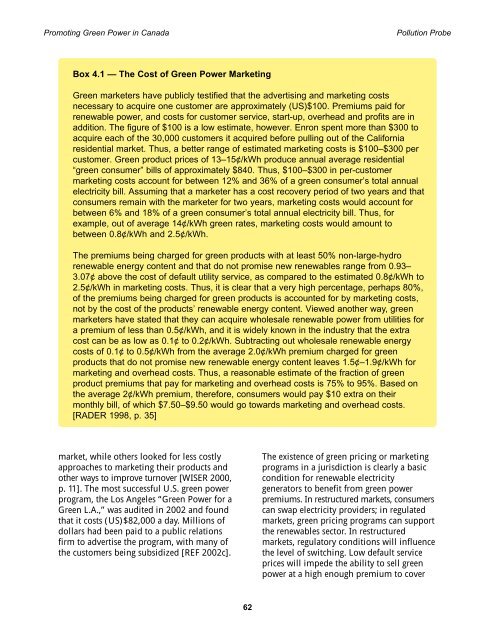Promoting Green Power in Canada - Centre for Human Settlements
Promoting Green Power in Canada - Centre for Human Settlements
Promoting Green Power in Canada - Centre for Human Settlements
- No tags were found...
Create successful ePaper yourself
Turn your PDF publications into a flip-book with our unique Google optimized e-Paper software.
<strong>Promot<strong>in</strong>g</strong> <strong>Green</strong> <strong>Power</strong> <strong>in</strong> <strong>Canada</strong> Pollution ProbeBox 4.1 — The Cost of <strong>Green</strong> <strong>Power</strong> Market<strong>in</strong>g<strong>Green</strong> marketers have publicly testified that the advertis<strong>in</strong>g and market<strong>in</strong>g costsnecessary to acquire one customer are approximately (US)$100. Premiums paid <strong>for</strong>renewable power, and costs <strong>for</strong> customer service, start-up, overhead and profits are <strong>in</strong>addition. The figure of $100 is a low estimate, however. Enron spent more than $300 toacquire each of the 30,000 customers it acquired be<strong>for</strong>e pull<strong>in</strong>g out of the Cali<strong>for</strong>niaresidential market. Thus, a better range of estimated market<strong>in</strong>g costs is $100–$300 percustomer. <strong>Green</strong> product prices of 13–15¢/kWh produce annual average residential“green consumer” bills of approximately $840. Thus, $100–$300 <strong>in</strong> per-customermarket<strong>in</strong>g costs account <strong>for</strong> between 12% and 36% of a green consumer’s total annualelectricity bill. Assum<strong>in</strong>g that a marketer has a cost recovery period of two years and thatconsumers rema<strong>in</strong> with the marketer <strong>for</strong> two years, market<strong>in</strong>g costs would account <strong>for</strong>between 6% and 18% of a green consumer’s total annual electricity bill. Thus, <strong>for</strong>example, out of average 14¢/kWh green rates, market<strong>in</strong>g costs would amount tobetween 0.8¢/kWh and 2.5¢/kWh.The premiums be<strong>in</strong>g charged <strong>for</strong> green products with at least 50% non-large-hydrorenewable energy content and that do not promise new renewables range from 0.93–3.07¢ above the cost of default utility service, as compared to the estimated 0.8¢/kWh to2.5¢/kWh <strong>in</strong> market<strong>in</strong>g costs. Thus, it is clear that a very high percentage, perhaps 80%,of the premiums be<strong>in</strong>g charged <strong>for</strong> green products is accounted <strong>for</strong> by market<strong>in</strong>g costs,not by the cost of the products’ renewable energy content. Viewed another way, greenmarketers have stated that they can acquire wholesale renewable power from utilities <strong>for</strong>a premium of less than 0.5¢/kWh, and it is widely known <strong>in</strong> the <strong>in</strong>dustry that the extracost can be as low as 0.1¢ to 0.2¢/kWh. Subtract<strong>in</strong>g out wholesale renewable energycosts of 0.1¢ to 0.5¢/kWh from the average 2.0¢/kWh premium charged <strong>for</strong> greenproducts that do not promise new renewable energy content leaves 1.5¢–1.9¢/kWh <strong>for</strong>market<strong>in</strong>g and overhead costs. Thus, a reasonable estimate of the fraction of greenproduct premiums that pay <strong>for</strong> market<strong>in</strong>g and overhead costs is 75% to 95%. Based onthe average 2¢/kWh premium, there<strong>for</strong>e, consumers would pay $10 extra on theirmonthly bill, of which $7.50–$9.50 would go towards market<strong>in</strong>g and overhead costs.[RADER 1998, p. 35]market, while others looked <strong>for</strong> less costlyapproaches to market<strong>in</strong>g their products andother ways to improve turnover [WISER 2000,p. 11]. The most successful U.S. green powerprogram, the Los Angeles “<strong>Green</strong> <strong>Power</strong> <strong>for</strong> a<strong>Green</strong> L.A.,” was audited <strong>in</strong> 2002 and foundthat it costs (US)$82,000 a day. Millions ofdollars had been paid to a public relationsfirm to advertise the program, with many ofthe customers be<strong>in</strong>g subsidized [REF 2002c].The existence of green pric<strong>in</strong>g or market<strong>in</strong>gprograms <strong>in</strong> a jurisdiction is clearly a basiccondition <strong>for</strong> renewable electricitygenerators to benefit from green powerpremiums. In restructured markets, consumerscan swap electricity providers; <strong>in</strong> regulatedmarkets, green pric<strong>in</strong>g programs can supportthe renewables sector. In restructuredmarkets, regulatory conditions will <strong>in</strong>fluencethe level of switch<strong>in</strong>g. Low default serviceprices will impede the ability to sell greenpower at a high enough premium to cover62
















